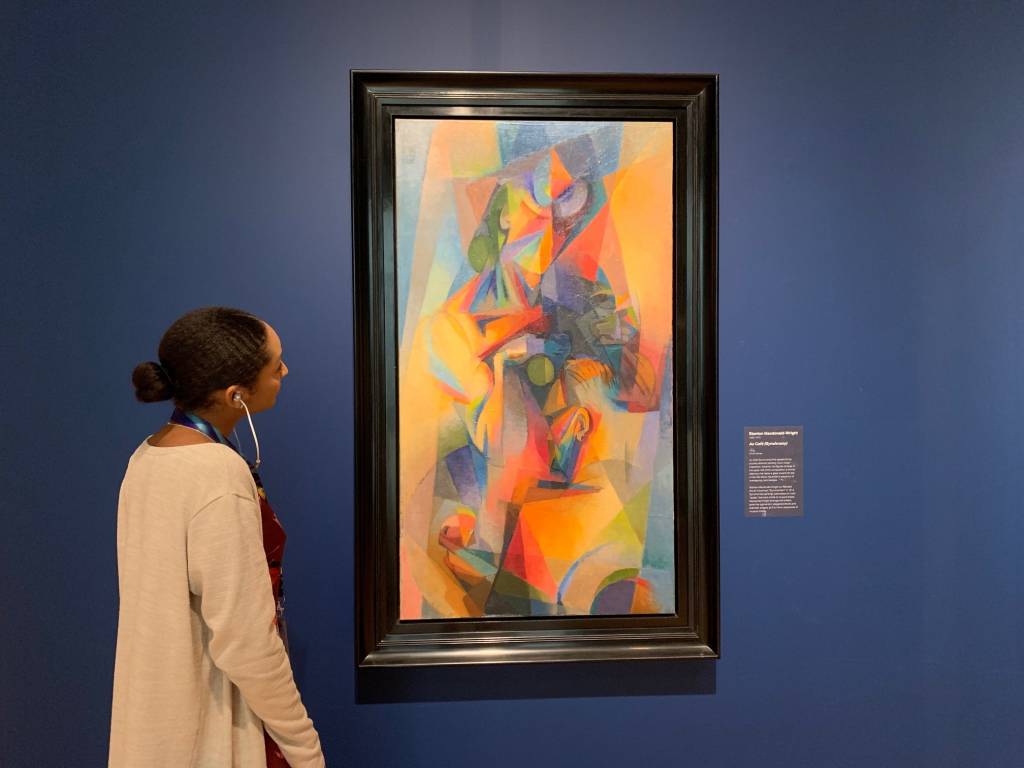When it comes to interpreting art at a museum, it’s easy to get lost in translation.
With all of the -isms of art styles and movements, artwork labels can become your best friend. But sometimes, people forget that there are many ways to interpret a work of art. One’s response to art isn’t measured on a scale of right or wrong. Art can flow through multiple sectors and media of itself, allowing viewers to interpret in their own way with either other forms of art or imagination.
Since music is a popular way of expression, check out how music from today’s top pop and hip-hop artists paired with artworks from our permanent collection for a unique and personal interpretation.
Sappho
William Wetmore Story

William Wetmore Story’s Sappho is a carved marble sculpture named after the Greek poet of love, Sappho. Story’s Sappho plays off the legend of her committing suicide for love. She wallows in thought in a Greek klismos chair, contemplating her death. Accompanying beside her is a lyre, an instrument often related to the joyful sound of praise and wilted rose, a symbol of anguished love. The two contrast from what was and is to be of Sappho.
Adele’s “Hello” from her album, 25, perfectly describes the effects of lost love on a person. Sappho mourns her lover in her final moments, stepping closer to the other side of life.
Jessica Penn in Black with White Plumes
Robert Henri

Robert Henri’s Jessica Penn in Black with White Plumes screams Rose from Titanic. Henri painted the soon-to-be-famous Broadway star as she searched to make her debut in the theater world. Although Miss Penn looks and is independent, elegant, and mysterious, behind her cold eyes she longs to be desired.
Nothing is more suitable for this artwork than Jessie J’s “Someone’s Lady.” Jessie’s voice has the ability to take one by surprise. Featured on her EP, Empowerment, this song will caress its listeners in a blanket of soft desire and melancholy.
The Song
William Merritt Chase

William Merritt Chase is known for his portrait paintings. Using oil on canvas, he painted the most important people of his time. Here displays his artwork titled The Song where a woman is lured into the melodic haze of reminiscence and solitude triggered by a song that a companion plays on the piano in the background.
Kate Stewart’s “RyRy” must be the song of the piano, representing the seconds where one slips away from reality. With her riffs and ever gracing tone, her voice locks listeners into a daze. For a quick 40 seconds, the woman replays a failed love situation. Stewart’s interlude is the literal song of how fast love starts and ends.
Dragoon
Walt Kuhn

Walt Kuhn’s Dragoon is inspired by his love for the arts, theater and costume design. Pictured is a woman circus performer who stares directly into the viewer. With her authoritative stance, one can’t help but ask, “what is she trying to say?”
Matched with Britney Spears’s “Circus,” this performer knows who she is. She takes charge of her role and outperforms her teammates. All eyes are on her as she takes the center ring of the circus.
Au Cafè
Stanton MacDonald-Wright

Stanton MacDonald-Wright’s Au Cafè was made to connect the qualities of color to those of music, referred to as Synchromism. Because this type of practice is akin to music, the mood of this artwork tends to change depending on the genre of music.
Popular French artist, Nicoletta, takes on MacDonald-Wright’s Au Cafè. Her somber and blues-inspired song “Où es-tu passé mon Saint-Germain-des Près,” pulls out all the cool colors of the painting, feeling as if you were actually in a rainy France drinking your cafè au lait.
The Cost of Removal
Titus Kaphar

Titus Kaphar’s The Cost of Removal depicts the muted intelligence of President Andrew Jackson. Portrayed to most as “the benevolent slave owner,” Kaphar removes the most important thing to an intelligent white man: his voice.
Nigerian American singer, Jidenna, discusses the severity of representation of black men in his music. As Jidenna uses his voice to warn his fellow black men of the dangers of society, “Helicopters/Beware” can be replaced with painted Jackson’s voice, corresponding to Jackson’s belief that slavery was the very thing to end America.
untitled
Joan Mitchell

Joan Mitchell’s untitled, oil in canvas artwork portrays her fierce attitude and style. Bold strokes smack the canvas as she works out her frustration of being labeled “second generation” by her male counterparts. The colors blur into one another and can be represented as the chaos of one’s mind.
Charli XCX’s electric pop single “5 in the morning” exposes her haters for being fake. Her hypnotic beats will have you ready to tell someone how you really feel about them. Pairing with Joan’s untitled, the two artists have no other choice but to get into their element and go all in till 5 in the morning.
This post was written by Dinah Benford, Marketing and PR Intern.




